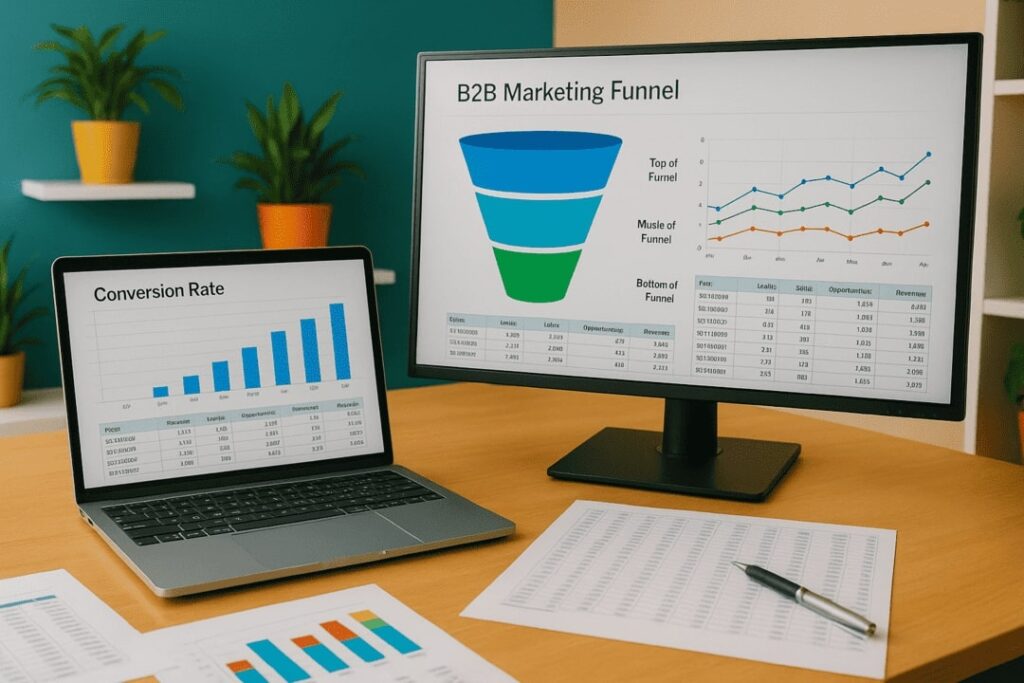B2B buyers research quietly and loop through stages before they ever talk to sales. Content needs to meet them where they are. In 2025, buyers face more channels, more content noise, and more stakeholders in every decision. This guide gives you a simple funnel you can map this week, with examples and metrics.
What a B2B content funnel is
A content funnel is a path that moves people from problem aware to confident decision. Content is the vehicle. The funnel has three layers. TOFU is top of funnel, where you create awareness and earn attention. MOFU is middle of funnel, where you help people compare options and shape criteria. BOFU is bottom of funnel, where you remove risk and make it easy to choose. Buyers jump around between marketing funnel stages, so your content should assume this.
TOFU: earn attention and trust
Your purpose here is to help prospects name the problem and see its impact. Formats that work now include expert articles, short video explainers, research-backed guides, interactive checklists, lightweight tools, LinkedIn newsletters, and podcasts with clear takeaways.
The angles that work best are practical how-tos tied to real pains, decision guides where “how to evaluate X” beats “what is X”, and contrarian takes that challenge unhelpful defaults without being edgy for the sake of it. Design for LinkedIn first, then repurpose every asset into three to five smaller pieces.
TOFU success signals include qualified traffic growth, save and forward behavior, repeat visitors from target accounts, and email signups from the right roles.
MOFU: shape criteria and lower uncertainty
Your purpose here is to move from interest to intent by clarifying tradeoffs, outcomes, and fit. Formats that work now include comparison guides, role-based playbooks, calculators, case studies with process detail, webinars with live Q&A, and product-led education like feature walkthroughs that teach a job to be done. A job to be done is the outcome someone wants to achieve, focused on the result rather than the feature.
The angles that work best are role-specific content where you create one version for the practitioner and one for the budget owner, before and after narratives with the steps and not just the results, and build versus buy, in-house versus partner, or phased rollout plans.
MOFU success signals include time on asset, return visits from buying committees, content to demo request rate, calculator completions, and webinar attendance to completion.
BOFU: make the decision safe
Your purpose here is to remove friction and prove success is repeatable. Formats that work now include on-demand demos, self-serve sandboxes or trials, implementation roadmaps, security and compliance one-pagers, customer proof with raw details, and ROI outlines with assumptions.
The angles that work best are week one to go-live plans with owners and milestones, risk-reversal content like data migration checklists and change management kits and support response examples, and procurement help like pricing explainers, vendor diligence packs, and stakeholder email templates.
BOFU success signals include trial starts with activation, demo to opportunity rate, sales cycle time by segment, and stakeholder coverage in CRM.
How to build your 2025 funnel in one week
This is a simple example of how you can approach creating your full-funnel marketing creation, as simple as possible. The objective is to start and test things out and have a basis from where to start to improve and extend the scope of work.
Day one is about mapping your buyer committee. List the three to five core roles like end user, manager, executive, finance, and security. Write one burning question each role has at each stage.
Day two is about auditing your content. Tag every asset by stage and role. Delete or retire weak pieces and keep only what a buyer would bookmark.
Day three is about filling the biggest gap with one high-leverage asset per stage. For TOFU, create an evaluation guide or problem explainer with a checklist. For MOFU, create a role-based calculator or comparison guide. For BOFU, create an implementation plan or on-demand demo with chapter markers.
Day four is about instrumenting everything. Add clear next steps on every page. Connect forms to CRM. Set up basic events like view, complete, click CTA, start trial, and book demo. CTA means call to action, which is the next step you want someone to take.
Day five is about distribution. Post natively on LinkedIn. Email your list with a note explaining what to use and when. Arm sales with links and one-line context for each asset.
How to measure your funnel
Track how people move through stages rather than surface, vanity driven numbers like page views. For TOFU, measure the percent of visitors from target industries who view two or more assets. For MOFU, measure the percent of role-based visitors who advance to a demo or calculator finish. For BOFU, measure activation rate within seven days of trial start and opportunity win rate when implementation content was viewed.
Inspect these numbers monthly. Look at which asset precedes a qualified opportunity. Look at where people stall, then fix it with a short bridge asset or clearer next step. Look at whether sales uses the assets, and if not, simplify and re-train.
Common mistakes to avoid
Producing content for everyone is a mistake. Every piece should name the role and the scenario. Writing about features without context is a mistake. Always tie to a job to be done and a business impact. Assuming the funnel is linear is a mistake. Link sideways and backwards between stages. Launching content without a next step is a mistake. Every asset needs a single, obvious action.
Example mini-funnel for a data-heavy SaaS
For TOFU, publish a guide called “how to evaluate data hygiene in your CRM” with a 10-point checklist. For MOFU, create role-based calculators where the ops lead estimates time saved, the CMO estimates campaign efficiency, and the CISO sees controls and audit trail. For BOFU, offer a 30-minute on-demand demo with chapters, plus a 30-day implementation plan template and a security pack download.
Final takeaways
A useful B2B funnel in 2025 is role-based, non-linear, and product-literate. Publish fewer, better assets. Make them easy to find, easy to finish, and easy to act on. Measure movement rather than clicks. Keep what works and cut the rest.
If you run a B2B tech startup and need help analyzing, auditing, or building your funnel, get in touch with us at milkandcookies.studio.



